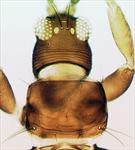
Head & pronotum

Antenna
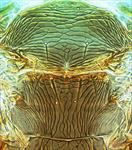
Mesonotum & metanotum
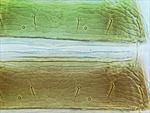
Tergites III–IV
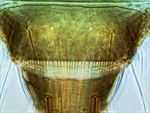
Tergite VIII–IX
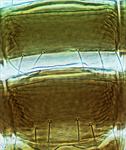
Sternites VI–VII

Fore wing
Female fully winged. Body brown, fore tarsi paler, antennal segment III yellow at base but light brown at apex; fore wings light brown, base pale but extreme apex darker. Antennae 8-segmented; segments III & IV with sense cone forked. Head longer than wide, constricted behind eyes with cheeks rounded; without sculpture between ocelli; two pairs of ocellar setae present, pair III longer than distance between compound eyes, arising between anterior margins of hind ocelli; pair II longer than side of ocellar triangle. Pronotum with few discal setae, 2 pairs of long posteroangular setae; posterior margin with one pair of prominent setae medially arising in front of margin. Metanotum with reticulation equiangular on anterior half but longitudinal on posterior half; median setae at anterior margin; campaniform sensilla present. Fore wing first vein with two setae on distal half; second vein with complete row of about 14 setae. Abdominal tergites with transversely reticulate sculpture medially; tergites VI–VIII with median setae about half length of tergite; tergite VIII with posteromarginal comb of long regular microtrichia. Sternites without discal setae.
There are 30 species listed in the genus Taeniothrips, together with a further 21 that are known only from fossils. Three species are European in origin, one is from western North America, and the rest are from Asia. The western North American species, T. orionis, is particularly similar to T. major Bagnall from the Himalayan region of northern India and Pakistan. In both of them the tergites are sculptured across the median area.
Probably breeding in a range of flowers, including Veratrum (Liliaceae), Polygonum (Polygonaceae), Solanum tuberosum (Solanaceae), and Paeonia sp. (Paeoniaceae), but with no recorded specificity. Bailey (1957) indicates that in California it occurs at high altitudes. This thrips has been associated with damage to crops of potatoes, but also reported from cabbage and lettuce.
Widespread in Western North America, and recorded from California, Oregon, Washington, Alaska, Montana, Wyoming, Colorado, Utah, and British Colombia.
THRIPIDAE - THRIPINAE
Taeniothrips orionis Treherne
Taeniothrips orionis Treherne, 1924: 86
Taeniothrips tahoei Moulton, 1927: 190
Taeniothrips pingreei Moulton, 1927: 191.
Bailey SF (1957) The thrips of California Part I: Suborder Terebrantia. Bulletin of California Insect Survey 4: 143–220.
Mound LA, Azidah AA & Ng YF (2012) Key to the non-fossil species of the genus Taeniothrips (Thysanoptera, Thripidae). Zootaxa 3414: 33–42.